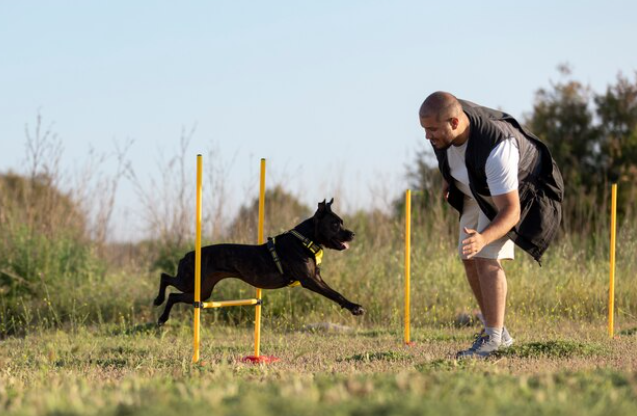Are you wondering when the right time is to start training your furry friend? Look no further! In this article, we will delve into the topic of the ideal age for dog training in Northern Virginia and provide you with expert advice to ensure your pup gets off to the right start.
Importance of Dog Training
Training is an essential part of a dog’s development, helping them become well-behaved and obedient companions. A trained dog is not only a joy to have around but also safer and more enjoyable to be with in various situations. From basic obedience commands to more advanced skills, training provides mental stimulation and strengthens the bond between you and your canine companion.
Factors to Consider When Determining the Right Age for Dog Training
But what is the right age to begin training your dog? While there is no one-size-fits-all answer, it’s important to consider certain factors. Puppies have a shorter attention span and may find it more challenging to focus on commands compared to adult dogs. However, they are also more eager to please and soak up new information like a sponge. Many experts recommend starting obedience training as early as 8 to 10 weeks old.
When deciding on the right age for training, it’s crucial to take into account your dog’s breed, temperament, and personality. Some breeds may mature more quickly than others, while certain temperaments may require additional time for socialization and confidence-building before formal training begins. Understanding your dog’s individual needs will help you determine the best age to start their training journey.
Early Socialization and Basic Obedience Training for Puppies
Early training sessions should focus on basic commands like sit, stay, and come, using positive reinforcement methods. Puppies are like sponges, eagerly absorbing information from their environment. By starting northern Virginia puppy training early, you can build a strong foundation that will benefit your dog throughout their life. Socialization is also crucial during this period, exposing your puppy to various people, animals, and environments to ensure they grow up to be well-adjusted and friendly dogs.
To begin training your puppy, set up short and frequent sessions that are fun and engaging. Use treats, praise, and rewards to reinforce desired behaviors and avoid punishment-based methods that can harm the trust and bond between you and your pup. Remember to keep the training sessions age-appropriate, considering your puppy’s attention span and energy levels. Patience and consistency are key to successful early training.
Training Considerations for Adolescent Dogs
As your puppy grows into adolescence, around six months to one year old, their training needs may change. Adolescent dogs often experience a surge in energy and independence, which can make training more challenging. However, this is also a critical time to reinforce and build upon the foundation laid during puppyhood.
Adolescent dogs may benefit from more advanced obedience training, such as walking politely on a leash, ignoring distractions, and mastering commands with increased distractions. This stage is also an excellent opportunity to explore specialized training activities like agility, scent work, or obedience competitions if your dog shows an interest. Consistency, positive reinforcement, and patience remain important during this stage of development.
Training Older Dogs – Challenges and Benefits
What if you have an older dog that hasn’t received any formal training? While it’s true that training an older dog can present additional challenges, it’s never too late to teach an old dog new tricks. Older dogs may have ingrained habits or behavioral issues that require extra attention and patience. Dog behavior modification training in Northern Virginia is critical to prevent recurrence of outbursts.
The benefits of training an older dog are numerous. Not only can you address unwanted behaviors, but training also provides mental stimulation and helps build confidence in older dogs. Training can help create a stronger bond with your dog and improve their overall quality of life. However, it’s important to tailor the training methods and expectations to suit your dog’s age and physical abilities.
Different Training Methods and Techniques for Different Age Groups
Each age group requires a slightly different approach to training. For puppies, positive reinforcement methods that focus on rewards and praise work best. Using treats and toys as rewards can help motivate and engage young dogs during training sessions. Short, frequent sessions that gradually increase in difficulty are effective for puppies.
Adolescent dogs may require more structured training sessions that include impulse control exercises, such as wait or leave it commands. Incorporating games and interactive toys can help keep them mentally stimulated and focused during training. Continued socialization with other dogs and people is also important during this stage.
Older dogs may benefit from a combination of positive reinforcement and gentle corrections, depending on their individual needs. Patience and consistency are key when training older dogs as they may take longer to learn new behaviors. Tailor the training to their physical abilities and consider any limitations they may have due to age or health conditions.
Signs That Your Dog is Ready for Training
How do you know if your dog is ready for training? While the age guidelines mentioned earlier provide a general starting point, it’s essential to assess your dog’s readiness individually. Look for signs of mental and physical readiness, such as the ability to focus, follow basic commands, and exhibit a desire to learn. If your dog consistently displays these behaviors, it’s a good indication that they are ready for more structured training.
Common Mistakes to Avoid When Training Dogs at Different Ages
Training dogs at different ages can be challenging, and it’s easy to make mistakes along the way. One common mistake is expecting too much too soon. Remember that each dog learns at their own pace, and pushing them too hard can lead to frustration and setbacks. Be patient and celebrate small victories.
Another common mistake is inconsistency. Dogs thrive on routine and consistency, so it’s important to establish clear expectations and remain consistent with your training methods. Inconsistency can confuse your dog and make it harder for them to understand what is expected of them.
Lastly, avoid using punishment-based training methods. These methods can harm the trust and bond between you and your dog and may have long-lasting negative effects on their behavior. Instead, focus on positive reinforcement and reward-based training techniques to foster a positive learning environment.
Professional Dog Training Services and Resources
If you feel overwhelmed or unsure about training your dog at any age, don’t hesitate to seek professional help. There are many qualified dog trainers and behaviorists who can provide guidance and support. Professional trainers can tailor training programs to meet your dog’s individual needs and address specific behavioral issues.
Additionally, there are numerous online resources, books, and videos available that can supplement your training efforts. These resources can provide valuable tips, techniques, and step-by-step guidance to help you navigate the training process.
Conclusion – Finding the Right Age for Dog Training Based on Individual Needs and Circumstances
In conclusion, there is no one-size-fits-all answer to the question of the right age for dog training. It’s crucial to consider your dog’s individual needs, breed, temperament, and personality when determining the ideal age to start training. Starting early with basic obedience training and socialization sets a solid foundation for your dog’s future development. However, older dogs can also benefit from training, albeit with some additional challenges.
Remember, training is a lifelong journey that requires patience, consistency, and positive reinforcement. By understanding your dog’s unique needs and using appropriate training methods, you can ensure they grow up to be well-behaved and obedient companions. Whether you choose to train your dog yourself or seek professional assistance, the key is to create a positive learning environment that nurtures their potential and strengthens the bond between you and your furry friend.







